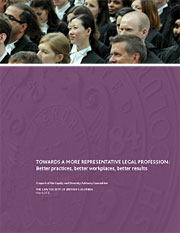British Columbia’s legal profession falls behind doctors, engineers, and other high-level career fields when it comes to diversity, a new
report from the Law Society of British Columbia shows.

In fact, about 14 per cent of the province’s lawyers were from visible minority groups in 2006, a number that falls far short of doctors at 26.1 per cent, engineers at 30.2 per cent, and high-level managers at 20.2 per cent. For university professors, 17.2 per cent were from visible minority groups. The numbers for lawyers compare to the overall representation of visible minorities in B.C.’s population at 25.3 per cent.
For aboriginals, the gap is even starker. The report pegs their numbers at 1.5 per cent of lawyers versus their overall representation in B.C.’s population at 4.6 per cent.
“We believe that we can do better and we need to do better,” said law society president Bruce LaRose in announcing the report. “A more diverse legal profession is better for clients, better for firms, and better for lawyers.”
The law society is calling on firms to do their part in changing things and hints their practices may be hindering visible minorities and aboriginals from advancing in the profession.
The report notes, for example, that visible minorities represent 32.6 per cent of university graduates with an occupation, “which suggests that their underrepresentation in the legal profession is not related to an inability to access university education. The data suggest there may be other reasons affecting the participation of visible minorities.
“One reason might be found in research from the U.S., which suggests that visible minorities are not advancing to leadership positions in the legal profession.”
For aboriginals, while they represented just 1.5 per cent of B.C. lawyers, they accounted for 1.3 per cent of university graduates with an occupation. That finding, the report noted, “suggests that one of the many factors involved in the underrepresentation of aboriginal lawyers may be related to social and economic conditions that may limit access to university education for aboriginal peoples.”
As for the role of law firms, the report identifies a number of ways in which they may be hindering people from minority groups. They include attribution bias, an issue identified in U.S. research that deals with the assumption that women’s success stems from luck and external circumstances rather than the personal skill and competence ascribed to many men.
Among the solutions to systemic barriers in the workplace, the report discusses bias-free performance evaluation and work-assignment systems.
Evaluation systems, for example, can focus on competencies and behaviours rather than subjective impressions through wording such as “can conduct dispositions with minimal supervision” rather than “shows initiative.”
In addition, formal work-assignment systems allow younger lawyers to indicate their availability and the skills and experience they wish to gain to partners assigning files. At the same time, the study notes flexible work arrangements through balanced-hours programs can help promote diversity.
Despite the overall tone and call for action, the report does indicate some improvements on diversity over the years. For visible minority groups, their representation increased to about 14 per cent in 2006 from 7.3 per cent in 1996. But the report also suggests that the need for action on in the issue is quite urgent. It notes, for example, that projections indicate the population of visible minorities in Vancouver will reach 59 per cent by 2031, up from 42 per cent in 2006. And with the aboriginal population in Canada increasing quickly, the report hints the gap will only grow if things don’t change soon.

 In fact, about 14 per cent of the province’s lawyers were from visible minority groups in 2006, a number that falls far short of doctors at 26.1 per cent, engineers at 30.2 per cent, and high-level managers at 20.2 per cent. For university professors, 17.2 per cent were from visible minority groups. The numbers for lawyers compare to the overall representation of visible minorities in B.C.’s population at 25.3 per cent.
In fact, about 14 per cent of the province’s lawyers were from visible minority groups in 2006, a number that falls far short of doctors at 26.1 per cent, engineers at 30.2 per cent, and high-level managers at 20.2 per cent. For university professors, 17.2 per cent were from visible minority groups. The numbers for lawyers compare to the overall representation of visible minorities in B.C.’s population at 25.3 per cent.